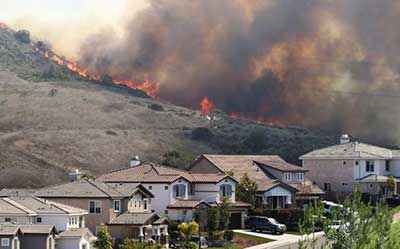Relevance: GS-3: Conservation, Environmental Pollution and Degradation, Environmental Impact Assessment.
Key Phrases: Fire Ready Formula, Wildfires, Land-urban interface, Greenhouse gases, Land and fire management, Global warming, Humid tropical forests, Savannah ecosystem, Fire-induced thunderstorms.
Why in News?
- Recently, the United Nations Environment Programme (UNEP), called on global governments to adopt a new ‘Fire Ready Formula,’ as it warned that incidences of wildfires would rise in the future.
- Wildfires are predicted to worsen in the coming years and decades, the United Nations Environment Programme (UNEP) has warned in its annual Frontiers report released February 17, 2022.
- Wildfires are one of three most important environmental issues to have emerged due to climate change, according to the report. The other two are noise pollution and shift in biological life cycles of plants and animals.
Status of wildfire globally:
- Between 2002 and 2016, an average of about 423 million hectares or 4.23 million square km of the earth’s land surface was burnt every year. This is equivalent to an area around size of the entire European Union.
- Savanna fire in African continent: In fact, 67 per cent of the annual global area burned by all types of fires, including wildfires, was on the African continent, according to estimates in the UNEP report.
- Australian Bushfires: The frequency of bushfires increased by 40% between 2007 and 2013. In Australia, the weather patterns are strongly associated with the El Niño Southern Oscillation (ENSO) and are exacerbated when there is a positive Indian Ocean Dipole (IOD), especially in the south east parts of the continent which causes low spring rainfall.
- Amazon fires and ecosystem tipping points: The Amazon saw a significant uptick in the number of fires across Brazil, Bolivia and Peru (with ~9000 km2 burnt) in 2019 due to human-driven deforestation, logging and exploitation.
Causes of wildfire:
Wildfires are a natural phenomenon, but are becoming more dangerous and affecting larger areas. The UN report has attributed this to climate change and human activities.
- Increased global warming and dry conditions: “The trends towards
more dangerous fire-weather conditions are likely to increase due to rising
concentrations of atmospheric greenhouse gases and the attendant escalation
of wildfire risk factors,” Inger Andersen, executive director, UNEP, said in
her foreword.
- “Extreme weather events such as hotter temperatures and more droughts lead to longer fire seasons and increase the likelihood of fire weather conditions,” the Frontiers report said.
- Encroachment of forest by expanding cities: There has been a
rapid expansion of cities towards forest areas in many regions in recent
decades.
- This wild land-urban interface is the area where wildfire risks are most pronounced, the report said, citing rising fires in California, United States.
- Change in land-use and land management practices are also responsible for the increasing risks of wildfires.
- Increased deforestation and forest fragmentation: Wildfires
seldom spread to humid tropical forests in the past. But these forests are
now more vulnerable due to deforestation and forest fragmentation.
- For example: Wildfires have also become more common in the Savannah ecosystem. It accounted for 77 per cent of the total 13 million individual fires (lasting for 4-5 days) which occurred globally between 2003 and 2016.
- Lightning ignition: It is the predominant driver of massive
wildfires in the boreal forests of North America and northern Siberia, the
report pointed out.
- Lightning strikes are projected to increase in frequency in some parts of the world as the climate changes.
- Fire-induced thunderstorms are a new danger posed by rising wildfires. This has been reported very frequently in Australia, Europe and North America.
What is the new ‘Fire Ready Formula’?
The new formula by UNEP, envisages that 66 percent of spending be devoted to planning, prevention, preparedness and recovery. The remaining 34 per cent can be spent on response.

- Integrated wildfire management: The UNEP in its report released jointly with non-profit GRID-Arendal said that the integrated wildfire management was key to adapting to current and future changes in global wildfire risk.
- Investment in collaborative approach: The report said, there is a need to invest more in fire risk reduction, work with local communities and strengthen global commitment to fight climate change.
- Need of comprehensive policy: As per UNEP, achieving & sustaining adaptive land and fire management requires a combination of policies, a legal framework and incentives that would encourage appropriate land and fire use.
- Development of International Cooperation and Standard: The UNEP has called for strengthening international and regional cooperation on wildfires. Development of an international standard for wildfire management has also been recommended.
It would facilitate international cooperation & help all wildfire-prone countries to build capacity for both domestic application & international assistance.
Approach to prevent wildfire:
A preventive approach, rather than reactive approach by engaging vulnerable groups, will help adapt to the wildfires. The report also recommended the following to improve monitoring and management of wildfires:
- Appreciating and adopting indigenous fire management techniques.
- Focus on long-range weather forecasting.
- Focus on remote-sensing capabilities such as satellites, ground-based radar, lightning detection as well as data handling.
- Enhance fire-fighting capabilities and strengthen community resilience-building programmes.
- Improved planning and policies coupled with practices.
Conclusion:
- An increase in damaging wildfires may reverse or delay progress towards achieving the United Nations Sustainable Development Goals (SDGs), Paris Agreement and Sendai targets, the UNEP said. Eliminating the risk of wildfires is not possible. But much could be done to manage and reduce risks.
- However, the direct responses to wildfires received over half of related expenditures, while planning and prevention received just 0.2 per cent of the total budget for wildfires. So, the current government responses to wildfires often put money in the wrong place. The Fire Ready Formula could help in achieving these goals, according to the UNEP.
Sources: Down-To-Earth
Mains Question:
Q. Explain the reasons for growing wildfires globally and suggest measures required to contain it. [250 words].







